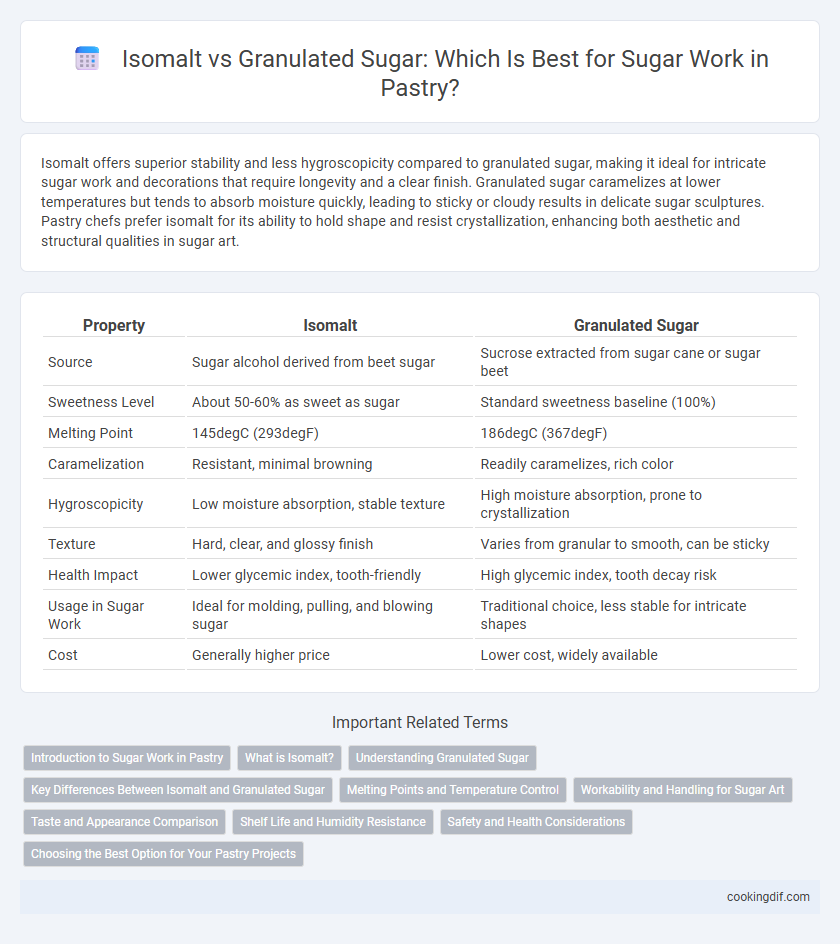Isomalt offers superior stability and less hygroscopicity compared to granulated sugar, making it ideal for intricate sugar work and decorations that require longevity and a clear finish. Granulated sugar caramelizes at lower temperatures but tends to absorb moisture quickly, leading to sticky or cloudy results in delicate sugar sculptures. Pastry chefs prefer isomalt for its ability to hold shape and resist crystallization, enhancing both aesthetic and structural qualities in sugar art.
Table of Comparison
| Property | Isomalt | Granulated Sugar |
|---|---|---|
| Source | Sugar alcohol derived from beet sugar | Sucrose extracted from sugar cane or sugar beet |
| Sweetness Level | About 50-60% as sweet as sugar | Standard sweetness baseline (100%) |
| Melting Point | 145degC (293degF) | 186degC (367degF) |
| Caramelization | Resistant, minimal browning | Readily caramelizes, rich color |
| Hygroscopicity | Low moisture absorption, stable texture | High moisture absorption, prone to crystallization |
| Texture | Hard, clear, and glossy finish | Varies from granular to smooth, can be sticky |
| Health Impact | Lower glycemic index, tooth-friendly | High glycemic index, tooth decay risk |
| Usage in Sugar Work | Ideal for molding, pulling, and blowing sugar | Traditional choice, less stable for intricate shapes |
| Cost | Generally higher price | Lower cost, widely available |
Introduction to Sugar Work in Pastry
Isomalt is favored in sugar work for its superior clarity, lower hygroscopicity, and ability to hold shape without crystallizing compared to granulated sugar. Granulated sugar, while more common and affordable, often introduces moisture and crystallization issues that can compromise delicate sugar decorations. Pastry chefs choose isomalt for intricate sugar sculptures and showpieces due to its stability and smooth finish, essential for professional sugar artistry.
What is Isomalt?
Isomalt is a sugar substitute derived from beet sugar, widely used in sugar work for its superior stability and resistance to humidity compared to granulated sugar. It melts at a lower temperature and creates glossy, clear, and heat-resistant decorations ideal for intricate pastry designs. Unlike granulated sugar, isomalt does not crystallize easily, making it preferred for detailed sugar art such as pulled or blown sugar.
Understanding Granulated Sugar
Granulated sugar, composed of fine sucrose crystals, offers reliable caramelization and crystallization properties essential for traditional sugar work like caramel and fondant. Its granular structure allows for precise control during heating, making it ideal for techniques that require melting and recrystallization, though it tends to absorb moisture, which can affect texture. Understanding granulated sugar's behavior is crucial for pastry chefs aiming to achieve consistent results in sugar art and confections.
Key Differences Between Isomalt and Granulated Sugar
Isomalt differs from granulated sugar primarily in its lower hygroscopicity, making it ideal for sugar work as it resists moisture and maintains structural integrity longer. Unlike granulated sugar, isomalt has a lower melting point and crystallizes more slowly, allowing for smoother molding and less stickiness in intricate sugar decorations. Its sugar alcohol properties result in reduced sweetness and increased stability, making isomalt preferable for elaborate pastry showpieces and sugar art.
Melting Points and Temperature Control
Isomalt offers a higher melting point around 145degC compared to granulated sugar's melting point of approximately 160degC, making it more stable and less likely to crystallize during sugar work. Precise temperature control is critical when working with granulated sugar to avoid caramelization or burning, whereas isomalt's stability allows easier handling for intricate sugar decorations. Pastry chefs prefer isomalt for sugar work requiring clarity and durability due to its enhanced temperature tolerance and resistance to moisture.
Workability and Handling for Sugar Art
Isomalt offers superior workability for sugar art due to its lower hygroscopicity and higher melting point compared to granulated sugar, resulting in less stickiness and easier molding. Granulated sugar tends to crystallize quickly, making it more challenging to handle and shape intricate designs without graininess. Isomalt's smooth texture and stability under humidity are preferred by pastry chefs for creating delicate and durable sugar sculptures.
Taste and Appearance Comparison
Isomalt offers a cleaner, less sweet taste than granulated sugar, making it ideal for intricate sugar work where a neutral flavor enhances the overall dessert experience. Its crystal-clear appearance resists browning and moisture absorption, resulting in glossy, stable decorations unlike the amber hue and potential crystallization of caramelized granulated sugar. Pastry chefs prefer isomalt for detailed sugar sculptures due to its superior clarity and extended shelf life compared to traditional granulated sugar.
Shelf Life and Humidity Resistance
Isomalt offers superior shelf life for sugar work due to its low hygroscopic nature, preventing moisture absorption and maintaining structural integrity over time. Granulated sugar, being highly hygroscopic, tends to absorb humidity, leading to stickiness and deformation in sugar decorations. The humidity resistance of isomalt makes it ideal for intricate sugar artistry that requires long-lasting durability and clarity.
Safety and Health Considerations
Isomalt is preferred over granulated sugar in sugar work due to its lower glycemic index and reduced risk of crystallization, enhancing safety for diabetics and those monitoring blood sugar levels. Unlike granulated sugar, isomalt produces less caramelization byproducts, minimizing the potential for harmful compounds such as acrylamide. Its non-hygroscopic nature also reduces microbial growth risks, making it a healthier option for long-lasting sugar decorations.
Choosing the Best Option for Your Pastry Projects
Isomalt offers superior clarity and stability for sugar work compared to granulated sugar, making it ideal for intricate pastry decorations and showpieces. Its resistance to humidity and slower crystallization process ensure longer-lasting structural integrity, crucial for professional confectionery art. Granulated sugar remains a versatile choice for everyday baking but lacks the durability and visual appeal required for advanced sugar craft.
Isomalt vs Granulated sugar for sugar work Infographic

 cookingdif.com
cookingdif.com